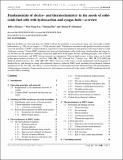Fundamentals of electro- and thermochemistry in the anode of solid-oxide fuel cells with hydrocarbon and syngas fuels
Author(s)
Lee, W.Y.; Hanna, Jeffrey; Alotaibi, Waleed Lafi; Ghoniem, Ahmed F
DownloadGhoniem_Fundamentals of.pdf (4.832Mb)
PUBLISHER_CC
Publisher with Creative Commons License
Creative Commons Attribution
Terms of use
Metadata
Show full item recordAbstract
Abstract
High fuel flexibility of solid-oxide fuel cells (SOFCs) affords the possibility to use relatively cheap, safe, and readily available hydrocarbon (e.g., CH₄) or coal syngas (i.e., CO-H₂ mixtures) fuels. Utilization of such fuels would greatly lower fuel cost and increase the feasibility of SOFC commercialization, especially for near-term adoption in anticipation of the long-awaited so-called “hydrogen economy”. Current SOFC technology has shown good performance with a wide range of hydrocarbon and syngas fuels, but there are still significant challenges for practical application. In this paper, the basic operating principles, state-of-the-art performance benchmarks, and SOFC-relevant materials are summarized. More in-depth reviews on those topics can be found in Kee and co-workers [Combust Sci and Tech 2008; 180:1207–44 and Proc Combust Inst 2005; 30:2379–404] and McIntosh and Gorte [Chem Rev 2004; 104:4845–65]. The focus of this review is on the fundamentals and development of detailed electro- and thermal (or simply, electrothermal) chemistry within the SOFC anode, including electrochemical oxidation mechanisms for H₂, CO, CH₄, and carbon, as well as the effects of carbon deposition and sulfur poisoning. The interdependence of heterogeneous chemistry, charge-transfer processes, and transport are discussed in the context of SOFC membrane-electrode assembly modeling.
Date issued
2013-10Department
Massachusetts Institute of Technology. Department of Mechanical EngineeringJournal
Progress in Energy and Combustion Science
Publisher
Elsevier
Citation
Hanna, J.; Lee, W.Y.; Shi, Y. and Ghoniem, A.F. "Fundamentals of electro- and thermochemistry in the anode of solid-oxide fuel cells with hydrocarbon and syngas fuels." Progress in Energy and Combustion Science 40 (February 2014): 74-111 © 2013 Elsevier Ltd
Version: Author's final manuscript
ISSN
0360-1285